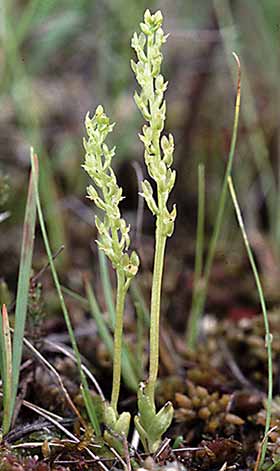Bog orchid (Malaxis paludosa)
When: July - Sept.
How many: Relatively small number of colonies containing varying numbers of plants

Fifteen orchid species can be found in the New Forest. Many are substantial, brightly coloured, readily noticed plants, but not bog orchids. Bog orchids are tiny, and could be described as an enthusiast’s orchid - not much to look at, and unlikely to be seen other than after a diligent search.
Britain’s smallest native wild orchid, bog orchids rarely attain a height of more than 8 centimetres (3 inches), the stems are pale green and there are none of the brightly coloured, extravagant flowers often associated with the group, just tiny yellow-green blooms that appear to be upside down compared to most other orchids.
Some bog orchids occasionally flower in late-June, but the main flowering period starts in July.
Pollination is by small flies, and the plants set conventional seeds, but also propagate vegetatively using minute bud-like structures cast from the tips of the oval, upper leaves.
Elsewhere in Britain, bog orchids are very rare indeed. In fact, throughout Europe in recent years bog orchids have severely declined as much of their lowland peat bog habitat has been lost to agriculture, afforestation, land-fill and peat extraction.
But the New Forest is a bog orchid stronghold. In fact, the New Forest has the second largest concentration of bog orchid populations in western Europe, following only the West Highlands of Scotland. To put that in context, however, the known number of bog orchid populations in the New Forest only just gets into double figures.
Accurately estimating numbers of sites and the number of bog orchid specimens at each site is, though, incredibly difficult, for bog orchids grow in the most inaccessible of places – they are most at home in the wettest parts of the valley mires, growing amongst a carpet of floating sphagnum moss. Bog orchids are also incredibly inconspicuous - the wholly green colouration blends superbly with the sphagnum mosses. Then to add to the difficulties, appearance from year-to-year is often erratic.
References:
Wild Orchids of Hampshire and the Isle of Wight: Martin N. Jenkinson
The Flora of Hampshire: Anne Brewis, Paul Bowman and Francis Rose
Collins New Generation Guide - Wild Flowers of Britain and Northern Europe: Alastair Fitter
More links
Other related links
Search this site

Sadly, 58 animals were killed - 35 ponies, 13 cows, 8 donkeys and 2 sheep, whilst a further 32 were injured - 3 pigs, 9 donkeys, 11 cows and 9 ponies.
(Forty-three accidents occurred in daylight, 15 at twilight and 101 in the dark. Twenty-seven accidents were not reported by the driver involved).
Here's just one horrific example - Three donkeys killed in collision with van at notorious New Forest blackspot (Advertiser and Times)

